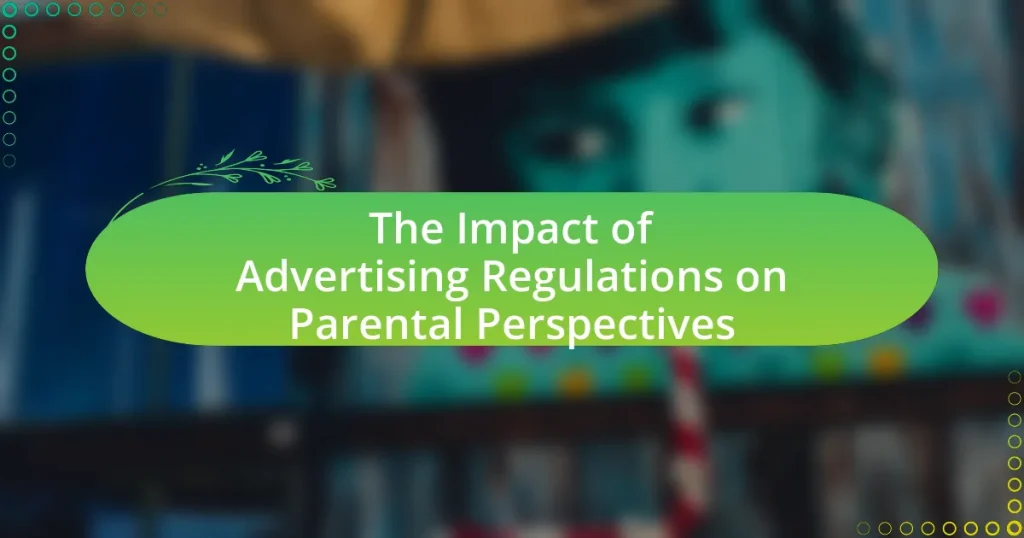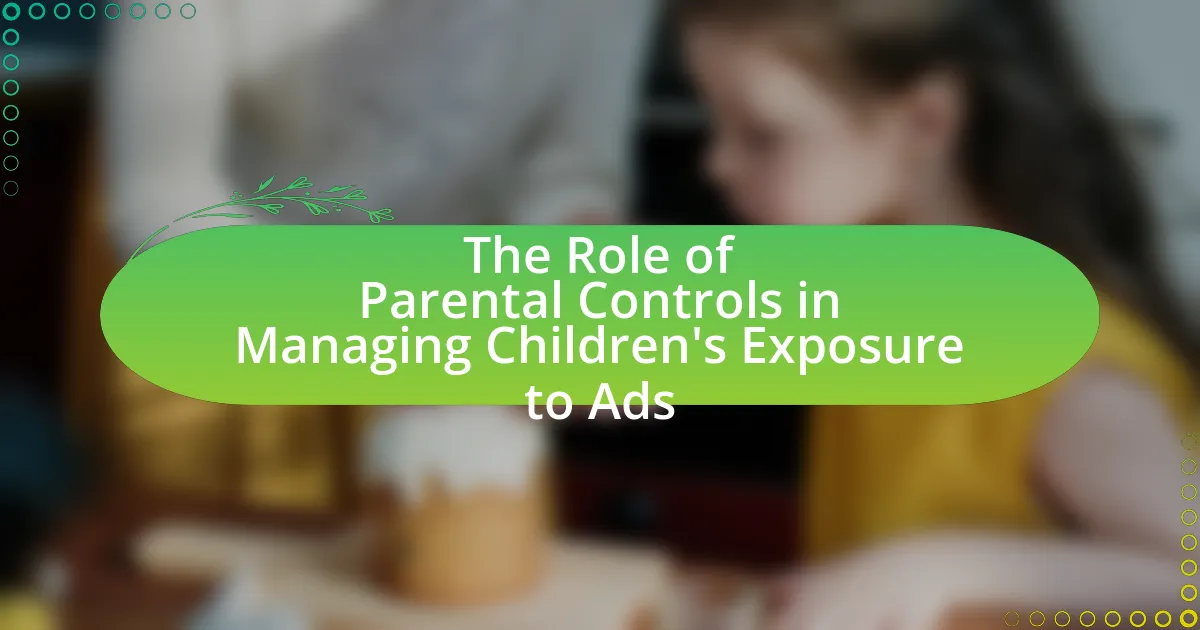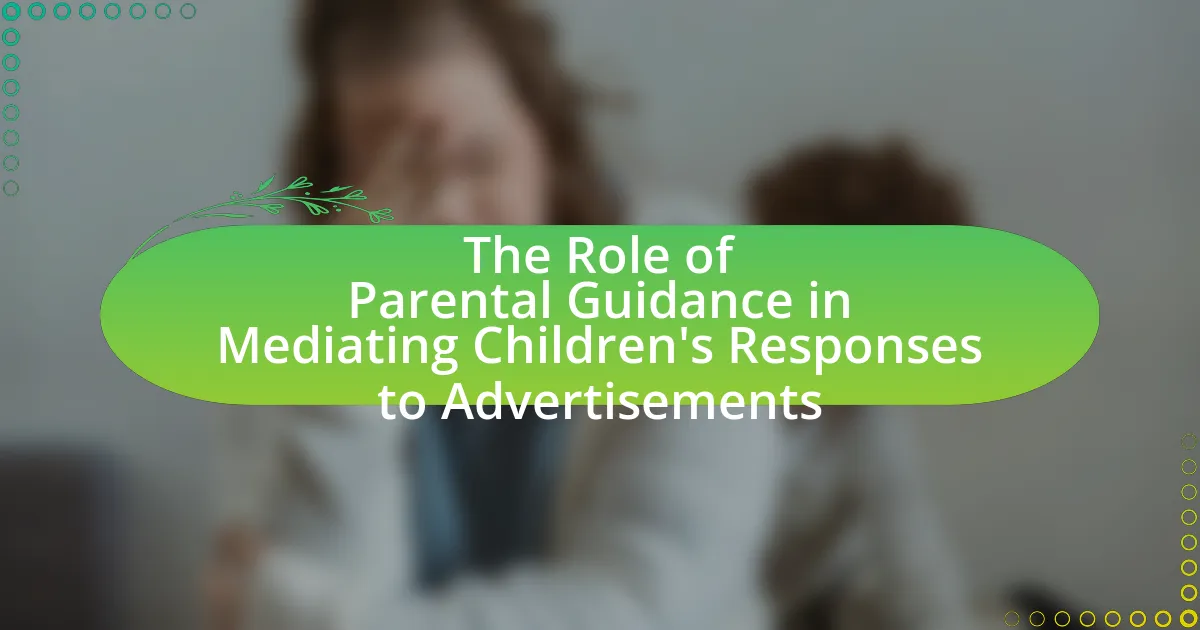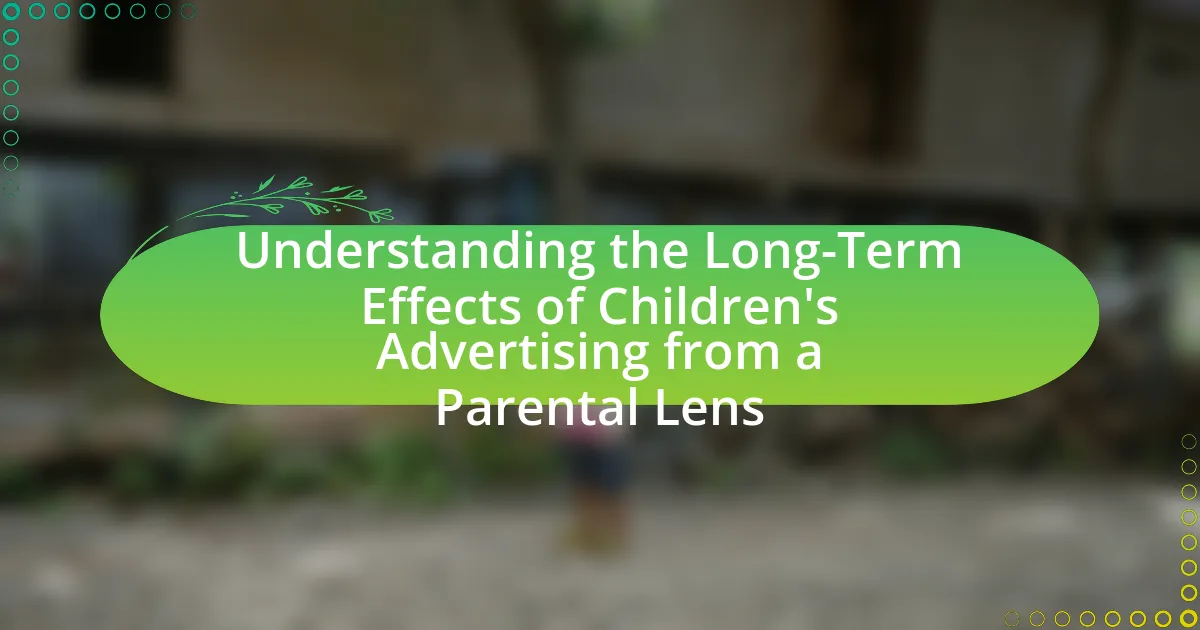Advertising regulations are legal guidelines designed to ensure that advertisements are truthful, not misleading, and socially responsible, primarily aimed at protecting consumers and promoting fair competition. This article examines the impact of these regulations on parental perspectives, particularly regarding children’s media consumption and the effectiveness of advertising practices. It explores specific regulations that safeguard children from harmful advertising, the varying enforcement of these regulations across different countries, and the role of parental advocacy in shaping advertising policies. Additionally, it addresses the challenges parents face in understanding these regulations and the adjustments companies make in response to them, ultimately highlighting the influence of advertising regulations on parental attitudes and the broader advertising landscape.

What are Advertising Regulations and Their Purpose?
Advertising regulations are legal guidelines that govern the content, placement, and dissemination of advertisements to ensure they are truthful, not misleading, and socially responsible. The primary purpose of these regulations is to protect consumers from deceptive practices and to promote fair competition among businesses. For instance, the Federal Trade Commission (FTC) in the United States enforces laws that require advertisers to substantiate claims made in their advertisements, thereby safeguarding consumer interests and maintaining market integrity.
How do advertising regulations impact children’s media consumption?
Advertising regulations significantly reduce children’s exposure to potentially harmful marketing practices. These regulations limit the types of products that can be advertised to children, such as junk food and sugary beverages, thereby influencing their media consumption patterns. For instance, the Children’s Television Act in the United States mandates that children’s programming includes a specific amount of educational content and restricts advertising during such programs. Research indicates that stricter advertising regulations correlate with lower rates of childhood obesity, as children are less likely to be influenced by unhealthy food advertisements. This demonstrates that effective advertising regulations can lead to healthier media consumption habits among children.
What specific regulations exist to protect children from harmful advertising?
Specific regulations that protect children from harmful advertising include the Children’s Online Privacy Protection Act (COPPA) in the United States, which restricts the collection of personal information from children under 13 without parental consent. Additionally, the Federal Trade Commission (FTC) enforces guidelines that prohibit deceptive advertising practices aimed at children, ensuring that advertisements are not misleading. In the European Union, the Audiovisual Media Services Directive (AVMSD) sets strict rules on advertising to children, including limitations on the types of products that can be advertised and the timing of such advertisements during children’s programming. These regulations are designed to safeguard children from exposure to harmful content and ensure that advertising is appropriate for their age group.
How do these regulations vary across different countries?
Advertising regulations vary significantly across different countries, influenced by cultural norms, legal frameworks, and economic conditions. For instance, in the United States, the Federal Trade Commission enforces regulations that focus on truthfulness and non-deceptive advertising, while in the European Union, the Audiovisual Media Services Directive imposes stricter rules on advertising to children, including limitations on the types of products that can be marketed. In contrast, countries like Australia have specific codes that address advertising to children, emphasizing the protection of minors from misleading content. These differences reflect varying societal values regarding child welfare and consumer protection, demonstrating that regulations are tailored to meet the unique needs and expectations of each country’s population.
Why are parental perspectives important in the context of advertising regulations?
Parental perspectives are important in the context of advertising regulations because they provide insights into how marketing strategies affect children and family dynamics. Parents are key stakeholders who can identify the potential risks of misleading or harmful advertising targeted at minors, which can lead to unhealthy consumption patterns. Research indicates that children are particularly vulnerable to advertising influences, as they may lack the cognitive skills to critically evaluate marketing messages. For instance, a study by the American Psychological Association highlights that children under the age of eight cannot distinguish between entertainment and advertising, underscoring the need for regulations that protect them. By incorporating parental viewpoints, regulators can create more effective policies that ensure advertising practices are ethical and prioritize children’s well-being.
How do parents perceive the effectiveness of advertising regulations?
Parents generally perceive advertising regulations as effective in protecting children from misleading or harmful content. Research indicates that parents support regulations that limit the exposure of children to aggressive marketing tactics, particularly in sectors like food and beverages. A study published in the Journal of Consumer Affairs found that 75% of parents believe stricter advertising regulations would help reduce unhealthy food choices among children. This perception is reinforced by concerns over the influence of advertising on children’s behavior and health, leading parents to advocate for policies that promote responsible advertising practices.
What role do parents play in shaping advertising policies?
Parents play a crucial role in shaping advertising policies by advocating for regulations that protect children from misleading or harmful marketing practices. Their concerns about the impact of advertising on children’s health and well-being have led to increased scrutiny and calls for stricter guidelines. For instance, organizations like the American Academy of Pediatrics have highlighted the need for policies that limit advertising to children, emphasizing the potential negative effects of exposure to unhealthy food advertisements. This advocacy has influenced legislative measures, such as the Children’s Online Privacy Protection Act, which aims to safeguard children’s personal information in advertising contexts.
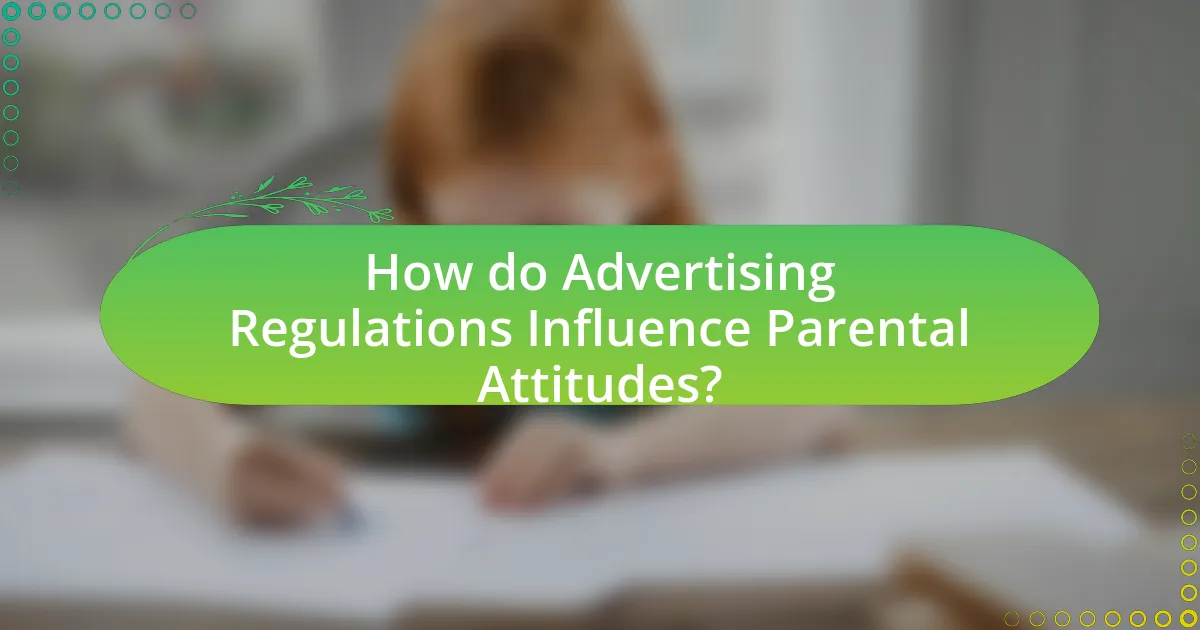
How do Advertising Regulations Influence Parental Attitudes?
Advertising regulations significantly influence parental attitudes by shaping the content and delivery of marketing messages directed at children. These regulations, such as restrictions on advertising unhealthy food during children’s programming, aim to protect children from misleading or harmful advertisements, which in turn fosters a more critical perspective among parents regarding the media their children consume. Research indicates that when parents perceive advertising as regulated and responsible, they are more likely to trust the brands and products being marketed, leading to increased confidence in their children’s consumption choices. For instance, a study published in the Journal of Advertising Research found that parents support stricter advertising regulations, believing they contribute to healthier lifestyle choices for their children.
What changes in parental attitudes have been observed since the implementation of advertising regulations?
Since the implementation of advertising regulations, parental attitudes have shifted towards increased skepticism and concern regarding the influence of marketing on children. Research indicates that parents now prioritize the protection of their children from potentially harmful advertising practices, reflecting a heightened awareness of the psychological effects of advertising. For instance, a study published in the Journal of Consumer Research found that 70% of parents expressed greater concern about the impact of advertisements on their children’s health and well-being post-regulation. This change signifies a more proactive stance among parents in advocating for responsible advertising practices that align with their values and the best interests of their children.
How do parents feel about the protection of their children from advertising?
Parents generally support the protection of their children from advertising, believing it is essential for their well-being. Research indicates that a significant majority of parents express concern about the impact of advertising on children’s health and behavior, with studies showing that 70% of parents feel that children are exposed to too much advertising. This concern is often rooted in the belief that advertising can manipulate children’s desires and contribute to unhealthy lifestyle choices, such as poor eating habits. Furthermore, parents advocate for stricter regulations on advertising targeted at children, reflecting their desire to create a safer environment for their children.
What concerns do parents have regarding the enforcement of these regulations?
Parents are primarily concerned about the enforcement of advertising regulations due to the potential for inadequate protection of their children from misleading or harmful content. They worry that regulations may not be strictly enforced, allowing companies to exploit loopholes and continue targeting children with inappropriate advertisements. Research indicates that parents feel a lack of transparency in how these regulations are implemented, which can lead to distrust in regulatory bodies. Additionally, parents express concerns about the effectiveness of these regulations in adapting to rapidly changing digital advertising landscapes, where traditional rules may not apply.
How do cultural differences affect parental perspectives on advertising regulations?
Cultural differences significantly influence parental perspectives on advertising regulations by shaping values, beliefs, and attitudes toward children’s exposure to marketing. For instance, in collectivist cultures, parents may prioritize community welfare and child protection, leading them to support stricter advertising regulations to shield children from harmful content. Conversely, in individualistic cultures, parents might emphasize personal responsibility and freedom of choice, resulting in a more lenient stance on advertising regulations. Research by the American Psychological Association indicates that cultural context plays a crucial role in how parents perceive the impact of advertising on children, highlighting that parents from different cultural backgrounds often advocate for varying levels of regulation based on their cultural norms and values.
What cultural factors influence parental views on advertising to children?
Cultural factors such as societal values, beliefs about childhood, and perceptions of consumerism significantly influence parental views on advertising to children. For instance, in collectivist cultures, parents may prioritize community and family-oriented messages in advertising, leading them to be more critical of ads that promote individualism or materialism. Additionally, cultural attitudes towards childhood can shape how parents perceive the appropriateness of advertising content; cultures that view childhood as a time for innocence may reject aggressive marketing tactics aimed at children. Research indicates that parents in countries with stricter advertising regulations, like Sweden, tend to have more negative views on advertising to children, reflecting a cultural emphasis on protecting children from commercial exploitation.
How do different cultural attitudes shape the effectiveness of advertising regulations?
Different cultural attitudes significantly influence the effectiveness of advertising regulations by determining societal norms and values regarding marketing practices. For instance, cultures that prioritize individualism may support more lenient advertising regulations, allowing for aggressive marketing strategies, while collectivist cultures often advocate for stricter regulations to protect community welfare and children from potentially harmful advertising. Research indicates that in countries like Sweden, where there is a strong emphasis on protecting children, advertising regulations are more stringent, resulting in lower exposure to aggressive marketing tactics aimed at children. Conversely, in the United States, cultural attitudes favoring free market principles lead to less restrictive advertising regulations, which can result in higher exposure to advertisements that may not align with parental perspectives on child welfare.

What are the Challenges and Limitations of Advertising Regulations?
Advertising regulations face several challenges and limitations, primarily due to the rapid evolution of digital media and varying interpretations of what constitutes misleading advertising. These regulations often struggle to keep pace with technological advancements, leading to gaps in enforcement and compliance. For instance, the rise of social media influencers has created ambiguity in disclosure requirements, making it difficult for regulators to ensure transparency. Additionally, the subjective nature of what is considered appropriate advertising can lead to inconsistent application of rules across different jurisdictions. Research by the Federal Trade Commission highlights that despite existing regulations, many advertisements still fail to meet standards for truthfulness and clarity, indicating a persistent challenge in effectively regulating advertising practices.
What challenges do parents face in understanding advertising regulations?
Parents face significant challenges in understanding advertising regulations due to the complexity and variability of the laws governing advertising practices. The regulations often differ by region and can be difficult to interpret, leading to confusion about what is permissible. For instance, the Federal Trade Commission (FTC) in the United States has specific guidelines regarding advertising to children, which may not be well-known to parents. Additionally, the rapid evolution of digital advertising platforms complicates the landscape, as traditional regulations may not adequately address new forms of advertising such as influencer marketing or targeted ads on social media. This lack of clarity can hinder parents’ ability to protect their children from misleading or harmful advertising practices.
How can parents stay informed about changes in advertising regulations?
Parents can stay informed about changes in advertising regulations by subscribing to updates from regulatory bodies such as the Federal Trade Commission (FTC) and the Children’s Advertising Review Unit (CARU). These organizations regularly publish guidelines and changes in advertising laws that affect children. Additionally, parents can follow relevant news outlets and industry publications that cover advertising and consumer protection topics. Engaging with advocacy groups focused on children’s rights can also provide insights and updates on regulatory changes.
What resources are available for parents to navigate advertising regulations?
Parents can access various resources to navigate advertising regulations, including government websites, consumer advocacy organizations, and educational materials. The Federal Trade Commission (FTC) provides guidelines and resources specifically aimed at helping parents understand advertising practices targeted at children. Additionally, organizations like Common Sense Media offer insights and tools for parents to evaluate media content and advertising. These resources are designed to empower parents with knowledge about advertising regulations, ensuring they can make informed decisions regarding their children’s exposure to advertising.
How do advertising regulations impact the marketing strategies of companies?
Advertising regulations significantly shape the marketing strategies of companies by imposing restrictions on content, targeting, and messaging. These regulations require companies to ensure that their advertisements are truthful, not misleading, and appropriate for the intended audience, which often leads to more cautious and compliant marketing approaches. For instance, the Federal Trade Commission (FTC) in the United States enforces guidelines that prevent deceptive advertising practices, compelling companies to invest in research and validation of claims made in their advertisements. Additionally, regulations may limit the use of certain channels or tactics, such as targeting children with specific products, thereby influencing companies to adapt their strategies to focus on compliant messaging that aligns with legal standards.
What adjustments do companies make in response to advertising regulations?
Companies adjust their advertising strategies in response to advertising regulations by modifying content, targeting, and compliance practices. For instance, they may alter the language and imagery used in advertisements to ensure they do not mislead consumers or violate specific guidelines. Additionally, companies often implement stricter age-targeting measures to prevent exposure to inappropriate content for children, aligning with regulations aimed at protecting young audiences. Compliance practices are also enhanced, with many firms investing in legal reviews and training for marketing teams to ensure adherence to local and international advertising laws. These adjustments are essential for maintaining brand reputation and avoiding legal penalties associated with non-compliance.
How do these adjustments affect the overall advertising landscape?
Adjustments in advertising regulations significantly reshape the overall advertising landscape by enforcing stricter guidelines on content targeting children. These regulations aim to protect young audiences from misleading or harmful advertisements, leading to a shift in how brands communicate their messages. For instance, the implementation of the Children’s Online Privacy Protection Act (COPPA) restricts data collection from children under 13, compelling advertisers to adopt more transparent and ethical marketing practices. Consequently, brands are increasingly focusing on responsible advertising strategies that prioritize consumer trust and compliance, ultimately transforming the competitive dynamics within the industry.
What practical steps can parents take to advocate for better advertising regulations?
Parents can advocate for better advertising regulations by organizing community groups to raise awareness and influence policymakers. These groups can engage in campaigns that highlight the negative effects of misleading advertisements on children, such as increased consumerism and unhealthy lifestyle choices. Research from the American Psychological Association indicates that children are particularly vulnerable to advertising, which underscores the need for stricter regulations. Parents can also participate in public forums and provide testimonies to local government meetings, emphasizing the importance of protecting children from harmful advertising practices. Additionally, parents can collaborate with advocacy organizations that focus on media literacy and responsible advertising, thereby amplifying their voices and efforts for change.
